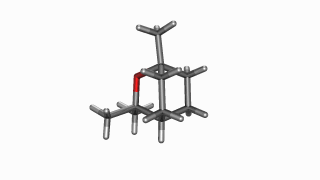Perfect for the cold and ‘flu season: Eucalyptus Oil
What does it look like?

The structure of Eucalyptol. The carbon atoms are grey, the oxygen atom is red and the hydrogen atoms are white. Images generated using POV-Ray (The Persistence of Vision Ray-Tracer; www.povray.org) and complied with VideoMach (www.gromada.com/videomach/).
What is it?
This is the crystal structure of Eucalyptol, also known as 1,8-cineole. Eucalyptol is the major component in Eucalyptus oil and is obtained from the leaves of Eucalyptus trees, many of which are indigenous to Australia. The leaves of these plants, which are toxic to many animals, are the primary food source of Koalas. Eucalyptus oil is a potent antiseptic and is also routinely used to relieve the symptoms of influenza and colds, acting as a decongestant when inhaled.
Eucalyptol is a monoterpene and is therefore closely related to many other strongly smelling natural products such as Limonene which has a strong orange smell. Eucalyptol is classed as a bicyclic molecule as it is formed from two fused six-membered rings. Unlike many other terpenes, this molecule has internal mirror symmetry, with the symmetry axis passing through the oxygen atom.
Where did it come from?
Despite research into Eucalyptol being performed for more than 100 years, its crystal structure was not obtained until 2001. To obtain the structure, single crystals had to be grown in situ on the diffractometer at -5 °C (just below its freezing point) using a floating-zone technique. This method of crystallisation is normally used for the purification of high-melting point solids such as silicon and ruby! The crystal structure was reported in: "Crystal Structure of Eucalyptol at 265 K", A. D. Bond, J. E. Davies, Aust. J. Chem., 2001, 54, 683-684 and is deposited in the CCDC. Refcode: MOFPAY






